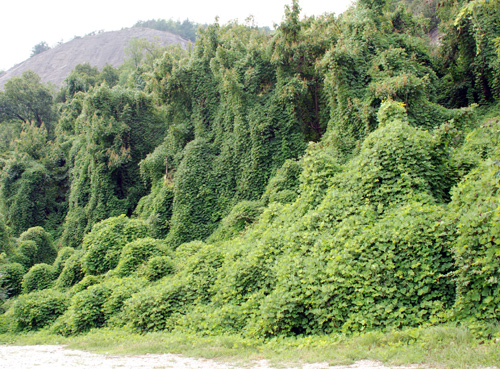7/20/17- KUDZU



By Meaghan English, TrueSouth Properties Wildlife Specialist
While we’re on the topic of invasive species, it’s time to talk about everybody’s worse nightmare: KUDZU. This invasive has spread all over this state and many more. It is almost impossible to eradicate and forms very dense infestations on any and every substrate it finds!
Pueraria montana, or Kudzu is an invasive vine that winds and twines up to 100 feet long! The vines are thick and woody, clinging on to trees and other vegetation and forming dense blankets. The plant contains large root balls that lie up to 16 feet below the soil surface. The leaves of the vine are very large with 3 separate leaflets. Each single leaflet is about 5 inches long and 6 inches wide. The vine begins to flower in June and the flowers die off in September. The flower itself is a purple color with a yellow center. Most people claim the flowers are very fragrant and smell somewhat like grapes or wine. Because Kudzu is part of the Fabaceae family, it produces large bean pods from September to January. The pods become ripe and fall off onto the ground or split in half, releasing seeds. These seeds are then wind and water dispersed. Animals also contribute to the planting of new seeds. The vine then begins to germinate from the newly planted seed, which is very hardy and seed viability depends on the habitat. In the spring, Kudzu can grow up to a foot per day! In one year, the vine can put on an extra 60 feet of growth! This astonishingly prolific vine occurs in all the stereotypical paces like right-of-ways, old home sites, and forest margins. It “blankets” trees, shrubs, small hills, old cars, etc.… The vine does not discriminate against the substrate it attaches to. It begins to twine around smaller parts of the object and then covers larger parts as it matures. The only pro to Kudzu is the fact that it is a nitrogen-fixer. So how did this highly invasive vine reach the United States? From Japan and China, of course! It came over to the states in the 1900s and was used for agricultural endeavors like feed for livestock and erosion control. It was also used in folk art. If we knew then, what we know now, Kudzu would not look like a green blanket across Alabama!
If Kudzu is suffocating your land, turn to the old trusty glyphosate. The herbicide has proven effective so far. The root ball also must be destroyed to prohibit reestablishment. In the meantime, the USDA is researching other ways to eradicate the invasive vine and rid the state of the green leaves that are blanketing this state and many others.





